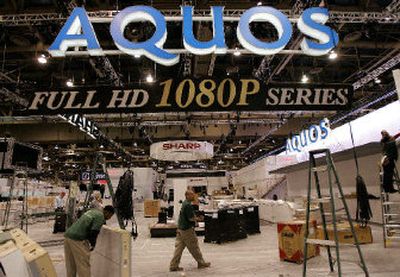Entertainment goes digital

Entertainment is going extreme as content providers, distributors and electronics makers race to keep pace in a world in which digital media becomes accessible anytime, anywhere.
The frenzy will be more evident than ever at next week’s International Consumer Electronics Show, a showcase of the latest products seeking to secure a spot in today’s digital age.
Information technology companies like Hewlett-Packard Co. and Microsoft Corp. will battle traditional electronics companies such as Sony Corp. and Samsung Electronics Co. over ways to link or directly bring Internet- and computer-based media to the television.
Technology startups like Pulse-LINK Inc. and Tzero Technologies Inc. will tout their chipsets as powerful engines to wirelessly move audio or high-definition video across different devices around the home. IBM Corp. will return after a 10-year hiatus to tout its microprocessors and software products that drive game consoles, cell phones and even karaoke machines.
Cellular carriers such as Verizon Communications Inc. and Sprint Nextel Corp. will likely talk about how they plan to use their pipelines to deliver video and engage subscribers in social-networking hangouts, while traditional media companies like the Walt Disney Co. and CBS Corp. are expected to discuss ways to extend their shows beyond the TV or PC.
“It’s the new CE — not consumer electronics,” said Jan-Luc Blakborn, HP’s director of digital entertainment. “We like to think of it as connected entertainment.”
When it comes to CES, what happens in Las Vegas isn’t meant to stay there.
First held in 1967 with 200 television and radio manufacturers hawking their wares, CES is now the world’s largest annual consumer technology extravaganza with some 2,700 exhibitors sprawled out over 1.7 million square feet of space.
That’s roughly 30 football fields brimming with thousands of gizmos seeking to get into the hands of consumers with the help of spectating hordes of media, gadget gurus and merchants.
Internet-enabled refrigerators, flat-panel televisions that take up entire walls, and other whiz-bang electronics will undoubtedly be in the crowded mix of the weird, tacky, or cool-but-too-expensive items on display.
But CES is no longer just about gadgets or the number of bells and whistles crammed into them.
It’s about the kind of content the gizmos can hold or deliver. It’s about the underlying partnerships and services. It’s about the ease with which the technology works. It’s about what really turns a consumer on.
And increasingly, it’s about the ability to access all your photos, music, videos, e-mails and other important files wherever and whenever.
The lines between personal and mass media have blurred, and so have the barriers between gadgets: TV programs on your mobile phone, downloadable movies on portable media players and game consoles, and friends’ photos on your TV.
“It gives you pause to reflect what CES has become and what it means to our company,” CBS President Leslie Moonves said. “It used to be one would go to see what the cool gadgets were. Now one goes there to see what cool gadgets are going to use our content and who the various players are that we’re going to be heading into the new era with.”
HP, which will debut its largest lineup of TVs, will have some models that can access movies, photos and music directly from computers along with movies from download services like CinemaNow and MovieLink.
Products from LG Electronics promise to work more easily with other devices, including home theater systems that let users control Apple Computer Inc.’s iPod players through TVs and playback songs purchased through Apple’s iTunes store.
“We’ve tried to add a lot of additional connectivity to take into account all the devices that people have today,” said Tim Alessi, LG’s director of product development.
American homes now have an average of 26 electronics products, and each household spends about $1,500 a year on consumer electronics, fueling the $150 billion industry, said Gary Shapiro, president and chief executive of the Consumer Electronics Association.
One company that will be missing from CES, however, is one that recently set a new bar for a successful, seamless blend of gadgetry, usefulness, marketing mastery, and accessible entertainment. Apple holds court instead at the competing Macworld Conference & Expo in San Francisco.
Apple dominates the digital music market and sparked new digital distribution models, thanks to its popular iPod portable players, well-designed iTunes jukebox software and a straightforward online store that sells digital songs at 99 cents a pop and television shows at $1.99 apiece.
And soon, Apple will release a product designed to bridge computers and television sets so users can more easily watch their downloaded movies on a big screen. Many analysts expect Apple to release more details about the device, dubbed iTV, at Macworld next week.
“The central focus (heading into CES) is all about digital entertainment,” said Satjiv Chahil, HP’s senior vice president of global marketing. “It helps when other companies — Apple being one of them — validates the trend.”